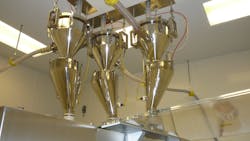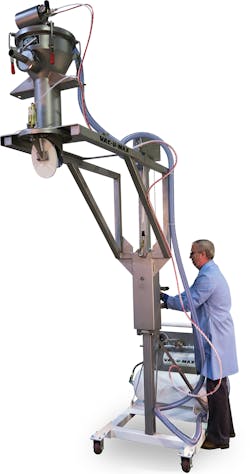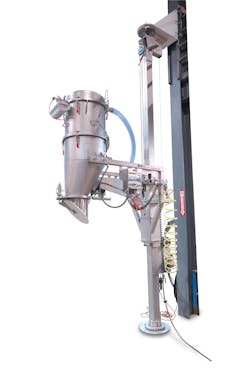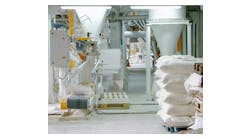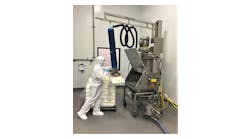Fine details in sanitary vacuum conveyor design increase bottom line
In industries where stringent FDA and USDA sanitary regulations require extensive cleaning, incorporating time-saving details into vacuum conveyor designs can be critical to minimize downtime, and therefore, reduce costs and increase throughput.
Vacuum conveying is an economical and efficient method of transferring powders and bulk solid materials. Compared to other conveying methods, it can eliminate ergonomic hazards, reduce cleaning times, increase process speeds, maximize food safety and preserve formula accuracy.
When a company is looking for a sanitary method to move bulk materials, there are several different technologies with sanitary design to choose from, but vacuum conveying is usually the best choice for sanitary transfer of powders.
Enclosed vacuum conveyors prevent loose powder from becoming airborne. If a leak occurs in a vacuum conveying system, the leak will be inward, preventing fugitive dust from escaping into the environment. This makes vacuum conveyors the preferred method of transfer for sanitary environments where preventing combustible dust hazards and cross contamination is essential.
Sanitary vacuum systems
There are different thresholds of hygienic design based on specific industry guidelines required for food, pharmaceutical, nutraceutical or cosmetics manufacturers. Although the FDA does not specifically address hemp processing, the CBD extracted from hemp is classified as a drug, and processors should follow pharmaceutical guidelines.
Sanitary and hygienic vacuum conveying systems, like standard conveying systems, have five basic components that come together to work as one: a pick-up point, convey tubing, a vacuum receiver, a vacuum producer and a control module.
From the pick-up point, material flows through stainless steel convey tubes to the vacuum receiver, where the material is separated from the airstream by filters and collects at the bottom of the receiver to be discharged through a valve in the receiver’s bottom. The vacuum producer is the heart of a pneumatic conveying system and works with the control panel to manage material flow through the convey tubes to the vacuum filter receivers.
What makes sanitary vacuum conveyors unique is that all parts and components must be sanitary, which means they are easy to clean and constructed with materials and fabrication techniques that meet current good manufacturing practices (cGMP). Food and drug manufacturing cGMPs specify general regulations for design, construction and fabrication of sanitary equipment.
In the realm of vacuum conveying, there are certain baseline standards that set the trajectory of a sanitary system design, and every component must comply with the standards. Filters, gaskets, vacuum hoses and valves, all constructed of FDA-approved materials, should include certificates of conformance with project documentation.
While all components included in systems comply with FDA regulations, more sophisticated valves, such as rotary valves and butterfly valves, are specialty designs unique to sanitation. For instance, rotary valves incorporate slide-out rotors and wafer, or butterfly valves, feature split-valve construction for easy sanitizing.
Stainless steel convey tubing is the standard in sanitary design. To facilitate quick disassembly and support ergonomic standards, manufacturers limit convey tubing to 10-foot lengths, which weigh less than 50 pounds. The easy-to-take-apart ferrules that connect the 10-foot sections comply with cGMP standards and require no tools for disassembly and re-assembly.
Surface finishes are important in sanitary design to limit places where material or bacteria can cling. The surface finish of product contact surfaces in a sanitary design will involve some level of interior and exterior polishing and mandatory grinding down of welds. Most customers call for maximum roughness measurements of RA 25 to 34, but the best sanitary design practices bring the roughness down to an RA between 10 and 15 as measured by a profilometer. Continuous welds and sleeved holes in hollow members should be standard.
Well-designed sanitary conveying components include passivation after fabrication. Passivation with nitric or citric acid removes free iron from the surface of components, providing a protective oxide layer that is less likely to allow moisture to stick to surfaces.
Any control elements located in a wash-down environment include stainless steel electrical enclosures standard and have a water-shedding design with a sloped top, sloped door edges and a NEMA 4X rating.
While most processors establish engineering standards for sanitary design unique to their facility, product and sanitation process, they may not know the most efficient way to clean the equipment. Working with a seasoned conveyor manufacturer with decades of experience designing efficient sanitary equipment can significantly reduce cleaning downtime.
One of the most important factors in sanitary design is the ability to clean equipment thoroughly and quickly. Processors looking at purchasing sanitary equipment should know how easy it is to take apart and wash.
Vacuum conveyors are often permanently installed above other process machinery and, therefore, more time consuming to clean to the extent required for sanitary applications.
Mobile and lift-mounted conveyors
Mobile and lift-mounted conveyors are complete conveying systems that raise and lower the vacuum receiver to load mixers, reactors and other processing equipment and then bring the vacuum receiver back down to ground level for cleaning or sanitizing.
Mobile vacuum conveying systems work with vacuum receivers up to 22 inches in diameter, include an on-board vacuum producer and control panel, and convey up to 5,000 pounds per hour. An operator uses a vacuum wand to safely transfer ingredients from floor level up to the receiver, where they discharge into a process vessel with a fill opening at 10 feet elevation. These units conform to the FDA’s Food Safety Modernization Act sanitation regulations and OSHA’s Walking-Working Surfaces standard. Mobile vacuum conveyors eliminate slip and fall hazards and back injuries that can result from repetitively carrying bags and boxes up steps to load process vessels.
The easy-to-clean floor-standing units are movable with one operator and able to service multiple process vessels at varying discharge heights. When not in use, they can be stored away from the work area, saving valuable floor space.
Lift-mounted conveyors, such as Vac-U-Max’s ColumnLift conveyors, can raise and lower vacuum receivers up to 22 feet, convey up to 5,000 pounds per hour and accommodate process vessels with fill ports 15 feet or more above the floor. They utilize an electric lift mechanism with a remote pendant controlled by an operator standing a safe distance away to raise and lower the conveying system above reactors, mixers, blenders or any vessels with open-and-close hatch doors.
These systems have top and bottom anchors and can load side-by-side process vessels from paper bags, drums, IBCs, boxes, bulk bags, silos, storage containers and feed bins.
Clean-in-place systems
Cleaning downtime can be devastating to a company; it can sometimes take one to two days to tear down a system and clean it. When production throughput demands a high level of cleanliness with minimal labor and time, clean-in-place (CIP) equipment can eliminate hours of downtime.
CIP is a procedure designed to clean all or parts of a process system without needing to completely disassemble or move equipment. CIP is the strategic placement of spray balls, or nozzles, within vessels that circulate water and cleaning solution to provide automatic and consistent cleaning performance. Although CIP has been around for a while, it is still a leading-edge technology and is gaining traction in the food, pharmaceutical, nutraceutical and cosmetics industries.
In CIP vacuum conveying systems, filter elements can be removed and replaced with insertable spray ball assemblies during cleaning. During the cleaning cycle, the pressure from the water or cleaning solutions extends the retractable spray balls outward for cleaning. The spray balls then self-retract after the cleaning cycle, so they do not interfere with the conveying process. Good sanitary vacuum conveyor design includes a package of simulated spray ball positioning and surface coverage documentation.
In one recent case, a nutraceutical beverage producer landed a large contract and needed to increase throughput and shorten the 8-hour cleaning cycle that occurred between batches to meet demand. To achieve this, the beverage producer replaced its 90-cubic-foot mixer with a 160-cubic-foot CIP mixer, a CIP vacuum receiver and a CIP bag dump station. These changes reduced sanitation from 8 hours to 1.75 hours — gaining 6.25 hours of production and reduced labor costs every day.
The CIP system also eliminated the need to develop a confined space plan with the new larger equipment, since the sanitation team did not need to enter the process vessel for cleaning.
Time-saving strategies
To save time, some processors have two sets of convey lines and/or two sets of filters, so they can quickly switch out dirty components with clean components and clean the dirty components while the next process runs.
Other processors, particularly those that run different flavors or colors, might have filters dedicated to certain ingredients (such as cherry or licorice, for instance).
The practice of keeping extra filters and tubing on hand can be employed with CIP or traditional sanitary systems to decrease the time it takes processors to get systems up and running again.
Sanitary design is a specialized field, so it is important work with an expert conveyor manufacturer that has worked with thousands of materials and has decades of experience building hygienic vacuum conveyor systems. They understand the different requirements for food, beverage, pharmaceutical, nutraceutical and cosmetic applications and know what must be done to provide processors with the most efficient sanitary powder and bulk solids transfer systems.
Doan Pendleton is President of Vac-U-Max, located in Belleville, New Jersey. His professional experience includes over 30 years in the design, engineering, manufacturing and marketing of dry bulk material transfer systems and industrial vacuum cleaning systems, with strong application expertise in the food, pharmaceutical, plastics, chemical and non-wovens industries. Pendleton holds a BS in marketing and management from Suffolk University.
Vac-U-Max
